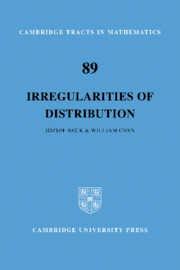Preface
Published online by Cambridge University Press: 06 January 2010
Summary
Although parts of it border on combinatorics and probability theory, irregularities of distribution began as a branch of the theory of uniform distribution, and may sometimes be described as a quantitative form of the theory. It originated from a conjecture of van der Corput and the work of van Aardenne-Ehrenfest, and owes its current prominence to the contribution of Roth and Schmidt.
Students and researchers in this area have benefited greatly from the excellent monograph of Schmidt published by the Tata Institute of Fundamental Research in 1977. However, Professor Schmidt pointed out to the second author in 1981 that his monograph was out of date and indicated that there was a need for one that would include the more recent work of Halász and Roth. When Professor Schmidt repeated this point in 1983, it was time to do something about the situation. With generous financial support from the Science and Engineering Research Council in Great Britain, the first author was able to spend the academic year 1984-85 at Imperial College London, and we made it our primary task to put Professor Schmidt's suggestion into reality.
In the last few years, much progress has been made in irregularities of distribution. From its early days where Roth's orthogonal function method played a crucial role, the subject has developed through an ever greater dependence on tools in harmonic analysis, first introduced by Halász in his use of Riesz products. In particular, the most recent work depends heavily on summability kernels (de la Vallée-Poussin kernels, Gauss kernels, Fejér kernels) and other standard tools of Fourier analysis.
- Type
- Chapter
- Information
- Irregularities of Distribution , pp. ix - xiiPublisher: Cambridge University PressPrint publication year: 1987
- 1
- Cited by



